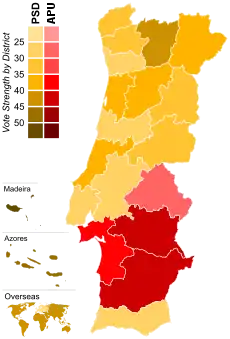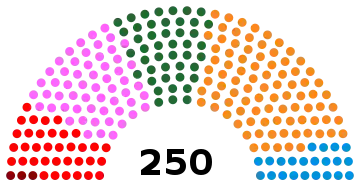1985 Portuguese legislative election
The Portuguese legislative election of 1985 took place on 6 October. The election renewed all 250 members of the Assembly of the Republic.
| |||||||||||||||||||||||||||||||||||||||||||||||||||||||||||||||||||||||||||||||||||||
250 seats to the Portuguese Assembly 126 seats needed for a majority | |||||||||||||||||||||||||||||||||||||||||||||||||||||||||||||||||||||||||||||||||||||
|---|---|---|---|---|---|---|---|---|---|---|---|---|---|---|---|---|---|---|---|---|---|---|---|---|---|---|---|---|---|---|---|---|---|---|---|---|---|---|---|---|---|---|---|---|---|---|---|---|---|---|---|---|---|---|---|---|---|---|---|---|---|---|---|---|---|---|---|---|---|---|---|---|---|---|---|---|---|---|---|---|---|---|---|---|---|
| Registered | 7,818,981 | ||||||||||||||||||||||||||||||||||||||||||||||||||||||||||||||||||||||||||||||||||||
| Turnout | 5,798,929 (74.2%) | ||||||||||||||||||||||||||||||||||||||||||||||||||||||||||||||||||||||||||||||||||||
| |||||||||||||||||||||||||||||||||||||||||||||||||||||||||||||||||||||||||||||||||||||
 Results by district or autonomous region. | |||||||||||||||||||||||||||||||||||||||||||||||||||||||||||||||||||||||||||||||||||||
| |||||||||||||||||||||||||||||||||||||||||||||||||||||||||||||||||||||||||||||||||||||
In June of the same year, the then incumbent Prime Minister, Mário Soares, resigned from the job due to the lack of parliamentary support, the government was composed by a coalition of the two major parties, the center-right Social Democratic and the center-left Socialist, in what was called the Central Bloc, however this was an unstable balance of forces and several members of each party opposed such alliance.
The new leader of the Social Democratic Party, Cavaco Silva, elected in May, was among those that never supported such alliance, and short after being elected leader of the party made the coalition fall in July. Mário Soares didn't run again and resigned as party leader, as he decided to run for the 1986 Presidential elections. The PS nominated Almeida Santos, minister of state in Soares government, as intern leader and as the party candidate for Prime Minister.
A new election was called by the President and the Social Democrats won with a short majority and Cavaco became the Prime-Minister. The election was the first of three consecutive election victories for the Social Democratic Party. Meanwhile, a new party had been founded by supporters of the President Ramalho Eanes, the Democratic Renewal Party, led by Hermínio Martinho that surprisingly gained 45 MPs and more than one million votes in the election and became the parliamentary support of the Cavaco's government until 1987, when it removed its support, making Cavaco fall.
The Communists and the Socialists lost votes and MPs, and the left would only return to the government ten years later, in 1995.
Electoral system
The Assembly of the Republic has 250 members elected to four-year terms. Governments do not require absolute majority support of the Assembly to hold office, as even if the number of opposers of government is larger than that of the supporters, the number of opposers still needs to be equal or greater than 126 (absolute majority) for both the Government's Programme to be rejected or for a motion of no confidence to be approved.[3]
The number of seats assigned to each district depends on the district magnitude.[4] The use of the d'Hondt method makes for a higher effective threshold than certain other allocation methods such as the Hare quota or Sainte-Laguë method, which are more generous to small parties.[5]
For these elections, and compared with the 1983 elections, the MPs distributed by districts were the following:[6]
| District | Number of MPs |
|---|---|
| Lisbon | 56 |
| Porto | 39 (+1) |
| Setúbal | 17 |
| Braga | 16 |
| Aveiro | 15 |
| Santarém | 12 |
| Leiria | 11 |
| Coimbra | 11 |
| Viseu | 10 |
| Faro | 9 |
| Viana do Castelo | 6 |
| Vila Real | 6 |
| Madeira | 5 |
| Azores | 5 |
| Beja | 5 |
| Castelo Branco | 5 |
| Évora | 5 |
| Guarda | 5 |
| Bragança | 4 |
| Portalegre | 3 (-1) |
| Europe | 2 |
| Outside Europe | 2 |
Parties
The table below lists the parties represented in the Assembly of the Republic during the 3rd legislature (1983-1985) and that also partook in the election:
Campaign period
Party slogans
| Party or alliance | Original slogan | English translation | Refs | |
|---|---|---|---|---|
| PS | « O que prometo, faço. Vamos a isto. » | "What I promise, I do. Let's do this." | [8] | |
| PSD | « Retomar a esperança » | "Resuming hope" | [9] | |
| APU | « Vitória da APU para salvar o país » | "Victory for APU to save the country" | [10] | |
| CDS | « Confiança, razão, força para Portugal » | "Trust, reason, strength for Portugal" | [11] | |
| PRD | « Mais Portugal » | "More Portugal" | [12] | |
Candidates' debates
| 1985 Portuguese legislative election debates | ||||||||||||||||||||
|---|---|---|---|---|---|---|---|---|---|---|---|---|---|---|---|---|---|---|---|---|
| Date | Organisers | Moderator(s) | P Present A Absent invitee N Non-invitee | |||||||||||||||||
| PS Santos |
PSD Cavaco |
APU Cunhal |
CDS Pires |
Refs | ||||||||||||||||
| 3 Sep | RTP1 | P | A[lower-alpha 2] | P | P | [13] | ||||||||||||||
| 5 Sep | RTP1 | N | A[lower-alpha 3] | P | P | [14] | ||||||||||||||
| 10 Sep | RTP1 | P | P | N | P | [15] | ||||||||||||||
| 12 Sep | RTP1 | P | P | P | N | [15] | ||||||||||||||
| Candidate viewed as "most convincing" in each debate | ||||||||||||||||||||
| Date | Organisers | Polling firm/Link | ||||||||||||||||||
| PS | PSD | APU | CDS | Notes | ||||||||||||||||
| 3 Sep | RTP1 | Expresso | 36 | N/A | 23 | 25 | 16% Neither | |||||||||||||
Opinion polling
The following table shows the opinion polls of voting intention of the Portuguese voters before the election. Those parties that are listed were represented in parliament (1983-1985). Included is also the result of the Portuguese general elections in 1983 and 1985 for reference.
| Date Released | Polling Firm | PS | PSD | APU | CDS | PRD | Others | Lead | |
|---|---|---|---|---|---|---|---|---|---|
| 6 Oct 1985 | Leg. Election | 20.8 57 seats |
29.9 88 seats |
15.5 38 seats |
10.0 22 seats |
17.9 45 seats |
5.9 0 seats |
9.1 | |
| 6 Oct (22:50) | RTP1 | 22.0–26.9 | 26.8–29.7 | 15.0–18.1 | 9.3–10.8 | 14.5–16.5 | – | 2.8–4.8 | |
| 6 Oct (21:10) | RTP1 | 23.8–26.9 | 28.0–29.8 | 17.3–18.1 | 9.8–10.7 | 11.1–14.9 | – | 2.9–6.0 | |
| 6 Oct | Rádio Comercial | 19.0–22.0 | 29.0–31.0 | 14.0–16.0 | 8.0–16.0 | 18.0–22.0 | – | 9.0–10.0 | |
| Exit polls | |||||||||
| 4 Oct | Expresso | 28.0–32.0 | 27.0–31.0 | 15.0–17.0 | 9.0–12.0 | 8.0–11.0 | – | 1.0 | |
| 1985 | |||||||||
| 25 Apr 1983 | Leg. Election | 36.1 101 seats |
27.2 75 seats |
18.1 44 seats |
12.6 30 seats |
Did not exist | 6.0 0 seats |
8.9 | |
National summary of votes and seats
 | ||||||||||
| Parties | Votes | % | ± | MPs | MPs %/ votes % | |||||
|---|---|---|---|---|---|---|---|---|---|---|
| 1983 | 1985 | ± | % | ± | ||||||
| Social Democratic | 1,732,288 | 29.87 | 75 | 88 | 35.20 | 1.18 | ||||
| Socialist | 1,204,321 | 20.77 | 101 | 57 | 22.80 | 1.10 | ||||
| Democratic Renewal | 1,038,893 | 17.92 | N/A | N/A | 45 | N/A | 18.00 | N/A | 1.00 | |
| United People Alliance[A] | 898,281 | 15.49 | 44 | 38 | 15.20 | 0.98 | ||||
| Democratic and Social Centre | 577,580 | 9.96 | 30 | 22 | 8.80 | 0.88 | ||||
| People's Democratic Union | 73,401 | 1.27 | 0 | 0 | 0.00 | 0.0 | ||||
| Christian Democratic | 41,831 | 0.72 | 0 | 0 | 0.00 | 0.0 | ||||
| Revolutionary Socialist | 35,238 | 0.61 | 0 | 0 | 0.00 | 0.0 | ||||
| Portuguese Workers' Communist | 19,943 | 0.34 | 0 | 0 | 0.00 | 0.0 | ||||
| Workers Party of Socialist Unity | 19,085 | 0.33 | 0 | 0 | 0.00 | 0.0 | ||||
| Communist Party (Reconstructed) | 12,749 | 0.22 | 0 | 0 | 0.00 | 0.0 | ||||
| Total valid | 5,653,610 | 97.49 | 250 | 250 | 100.00 | — | ||||
| Blank ballots | 48,709 | 0.84 | ||||||||
| Invalid ballots | 96,610 | 1.67 | ||||||||
| Total | 5,798,929 | 100.00 | ||||||||
| Registered voters/turnout | 7,818,981 | 74.16 | ||||||||
| A Portuguese Communist Party (35 MPs) and Portuguese Democratic Movement (3 MPs) ran in coalition.[16] | ||||||||||
| Source: Comissão Nacional de Eleições | ||||||||||
Distribution by constituency
| Constituency | % | S | % | S | % | S | % | S | % | S | Total S |
|---|---|---|---|---|---|---|---|---|---|---|---|
| PSD | PS | PRD | APU | CDS | |||||||
| Azores | 48.3 | 3 | 20.1 | 1 | 15.2 | 1 | 4.4 | - | 6.5 | - | 5 |
| Aveiro | 38.4 | 6 | 23.0 | 4 | 13.4 | 2 | 6.5 | 1 | 13.5 | 2 | 15 |
| Beja | 13.7 | 1 | 20.1 | 1 | 11.6 | - | 44.9 | 3 | 2.2 | - | 5 |
| Braga | 32.8 | 6 | 21.8 | 4 | 16.8 | 3 | 8.5 | 1 | 14.0 | 2 | 16 |
| Bragança | 39.2 | 2 | 22.7 | 1 | 6.9 | - | 5.3 | - | 17.1 | 1 | 4 |
| Castelo Branco | 31.2 | 3 | 18.5 | 1 | 24.4 | 2 | 8.9 | - | 9.6 | - | 6 |
| Coimbra | 29.5 | 4 | 28.5 | 3 | 16.9 | 2 | 10.1 | 1 | 8.6 | 1 | 11 |
| Évora | 19.1 | 1 | 14.3 | 1 | 15.8 | 1 | 41.2 | 2 | 3.3 | - | 5 |
| Faro | 28.4 | 3 | 22.3 | 2 | 20.5 | 2 | 15.4 | 2 | 6.1 | - | 9 |
| Guarda | 33.6 | 2 | 23.3 | 2 | 10.9 | - | 5.2 | - | 19.5 | 1 | 5 |
| Leiria | 38.6 | 5 | 19.6 | 2 | 15.3 | 2 | 7.9 | 1 | 12.2 | 1 | 11 |
| Lisbon | 25.6 | 15 | 19.8 | 12 | 21.3 | 13 | 20.1 | 12 | 8.1 | 4 | 56 |
| Madeira | 56.8 | 4 | 13.2 | 1 | 9.7 | - | 3.2 | - | 7.8 | - | 5 |
| Portalegre | 20.9 | 1 | 23.7 | 1 | 18.9 | - | 25.2 | 1 | 4.9 | - | 3 |
| Porto | 29.3 | 12 | 23.6 | 10 | 20.5 | 8 | 12.1 | 5 | 9.8 | 4 | 39 |
| Santarém | 27.8 | 4 | 18.6 | 2 | 23.8 | 3 | 16.4 | 2 | 7.7 | 1 | 12 |
| Setúbal | 15.4 | 3 | 16.5 | 3 | 20.4 | 4 | 38.2 | 7 | 3.8 | - | 17 |
| Viana do Castelo | 33.5 | 3 | 18.4 | 1 | 16.2 | 1 | 8.2 | - | 16.6 | 1 | 6 |
| Vila Real | 42.2 | 3 | 23.0 | 2 | 8.6 | - | 5.9 | - | 12.5 | 1 | 6 |
| Viseu | 37.7 | 5 | 20.0 | 2 | 10.9 | 1 | 5.0 | - | 19.9 | 2 | 10 |
| Europe | 24.3 | 1 | 24.2 | 1 | 7.1 | - | 18.8 | - | 17.3 | - | 2 |
| Rest of the World | 40.5 | 1 | 7.8 | - | 3.3 | - | 2.6 | - | 37.9 | 1 | 2 |
| Total | 29.9 | 88 | 20.8 | 57 | 17.9 | 45 | 15.5 | 38 | 10.0 | 22 | 250 |
| Source: Comissão Nacional de Eleições | |||||||||||
Maps
.png.webp) Most voted political force by municipality.
Most voted political force by municipality.
Notes
- The Portuguese Communist Party (PCP) and the Portuguese Democratic Movement (MDP/CDE) contested the 1983 election in a coalition called United People Alliance (APU) and won a combined 18.1% of the vote and elected 44 MPs to parliament.
- Aníbal Cavaco Silva, PSD leader, refused to participate in the debate.
- Aníbal Cavaco Silva, PSD leader, refused to participate in the debate, being replaced by Eurico de Melo, however, the latter was forbidden from participating.Fundação Mário Soares 1985
References
- Assembleia da República - Deputados e Grupos Parlamentares
- Assembleia da República - Deputados e Grupos Parlamentares
- "Constitution of the Portuguese Republic" (PDF). Archived from the original (PDF) on 2016-03-03. Retrieved 2019-12-29.
- "Effective threshold in electoral systems". Trinity College, Dublin. Retrieved 2015-10-21.
- Gallaher, Michael (1992). "Comparing Proportional Representation Electoral Systems: Quotas, Thresholds, Paradoxes and Majorities"
- "Eleição da Assembleia da República de 6 de Outubro de 1985". CNE - Comissão Nacional de Eleições - Eleição da Assembleia da República de 6 de Outubro de 1985. Retrieved 3 December 2020.
- Composição dos Grupos Parlamentares/Partidos
- "ELEIÇÕES LEGISLATIVAS DE 1985 – PS". EPHEMERA (in Portuguese). Retrieved 11 May 2020.
- "ELEIÇÕES LEGISLATIVAS DE 1985 – PSD". EPHEMERA (in Portuguese). Retrieved 11 May 2020.
- "ELEIÇÕES LEGISLATIVAS DE 1985 – APU". EPHEMERA (in Portuguese). Retrieved 11 May 2020.
- "ELEIÇÕES LEGISLATIVAS DE 1985 – CDS". EPHEMERA (in Portuguese). Retrieved 11 May 2020.
- "Evolução da Comunicação Política e Eleitoral em Portugal" (in Portuguese). Retrieved 11 May 2020.
- "Líderes partidários em confronto na TV". Fundação Mário Soares (in Portuguese). 1985. Retrieved 11 May 2020.
- "Álvaro Cunhal/Lucas Pires esta noite na RTP". Fundação Mário Soares (in Portuguese). 1985. Retrieved 11 May 2020.
- "Eleições ganham-se na TV?". Fundação Mário Soares (in Portuguese). 1985. Retrieved 11 May 2020.
- Electoral results - Assembly of the Republic
Sources
- Fundação Mário Soares (1985). "Eurico de Melo parte loiça nos estúdios de televisão" (in Portuguese). Retrieved 11 May 2020.

.png.webp)

.jpg.webp)